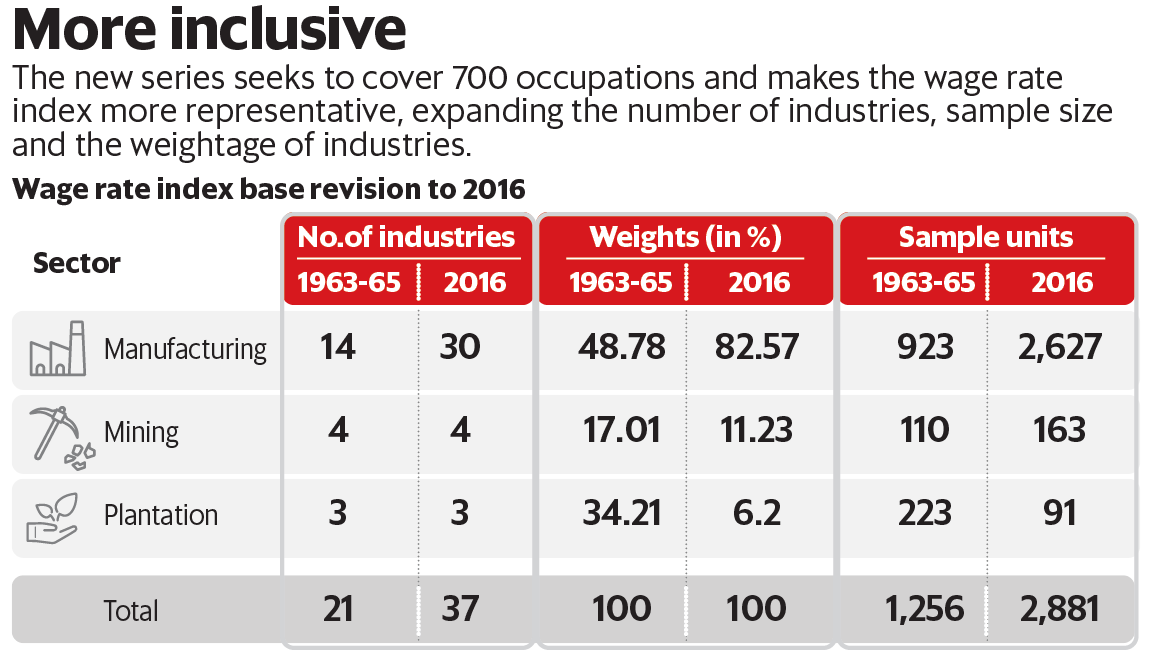Indian Economy
Wage Rate Index (WRI)
- 04 Dec 2021
- 4 min read
Why in News
Recently, the government has revised the base year for Wage Rate Index (WRI) to 2016 which will replace the old series with a base of 1963-65.
- The Wage Rate Index Number measures the relative changes in wage rates over a period of time, high or low Wage Rate Index in an industry does not necessarily indicate high or low wage rate in that industry as compared to other industries.
- A base year is the first of a series of years in an economic or financial index and is typically set to an arbitrary level of 100.
Key Points
- About:
- The Ministry of Labour & Employment has released a new series of Wage Rate Index (WRI) with base year 2016, being compiled and maintained by the Labour Bureau, an attached office of the ministry.
- It is based on the recommendations of the International Labour Organization and the National Statistical Commission.
- The new series on WRI has been compiled on a half-year basis (on the first of January and July every year) as against the annual in the existing series.
- The new WRI basket (2016=100) has enhanced the scope and coverage in terms of occupations and industries as compared to old WRI series (1963-65=100).
- Of the 37 industries covered in the new series, 16 new ones - including textile garments, footwear and petroleum - have been added under the manufacturing sector.
- In the new series, the oil mining industry has been introduced in the basket in place of mica mines industry, to make the mining sector more representative of the three different kinds of mining namely coal, metal and oil.
- Total 3 plantation industries namely tea, coffee and rubber have been retained in the new WRI basket with enhanced coverage.
- The top five industries - motor vehicles, coal mines, textile garments, iron & steel and cotton textiles together account for 46% of the total weight.
- Expected Benefits:
- The revised base will be more representative and play a critical role in determining the minimum wages and national floor wages along with other parameters.
- The government periodically revises the base year for major economic indicators to reflect the changes in the economy and to capture the wage pattern of workers.
- It provides useful tips to employers on deciding on the appropriate human resource strategy.
- WRI 2020:
- The All India Wage Rate Index Number for all the 37 industries stood at 119.7 in 2020 (half yearly 2) which shows an increment of 1.6% over the index in 2020 (half yearly 1).
- At sector level, the highest Wage Rate Index in 2020 (half yearly 2) was reported in the Plantation Sector followed by the Manufacturing Sector and Mining Sector.
- Highest Wage Rate Index:
- The highest Wage Rate Index was recorded in Drugs & Medicines, followed by Sugar, Motor Cycles, Jute Textiles and Tea Plantation.
- Lowest Wage Rate Index:
- The lowest Wage Rate Index was recorded in Rubber Plantation, followed by Paper, Castings & Forgings , Woollen Textiles and Synthetic Textiles.







